| Listing 1 - 8 of 8 |
Sort by
|
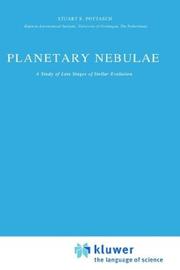
ISBN: 9027716722 9400972350 9400972334 Year: 1984 Volume: v. 107 Publisher: Dordrecht ; Boston, MA : D. Reidel,
Abstract | Keywords | Export | Availability | Bookmark
 Loading...
Loading...Choose an application
- Reference Manager
- EndNote
- RefWorks (Direct export to RefWorks)
Nebulae [Planetary ] --- Nevels [Planetaire ] --- Nébuleuses planétaires --- Planetaire nevels --- Planetary nebulae --- 52 --- Nebulae, Planetary --- Interstellar matter --- Stars --- Astronomie. Astrofysica. Ruimteonderzoek. Geodesie --- Planetary nebulae.
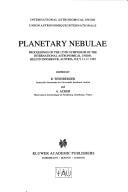
ISSN: 17439213 ISBN: 0792324390 0792324404 9401120889 Year: 1993 Publisher: Dordrecht : Kluwer,
Abstract | Keywords | Export | Availability | Bookmark
 Loading...
Loading...Choose an application
- Reference Manager
- EndNote
- RefWorks (Direct export to RefWorks)
Bibliothèque Houziaux
52 <063> --- Planetary nebulae --- -Nebulae, Planetary --- Interstellar matter --- Stars --- Astronomie. Astrofysica. Ruimteonderzoek. Geodesie--Congressen --- Congresses
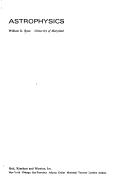
ISBN: 0030791553 9780030791550 Year: 1973 Publisher: New York : Holt, Rinehart and Winston,
Abstract | Keywords | Export | Availability | Bookmark
 Loading...
Loading...Choose an application
- Reference Manager
- EndNote
- RefWorks (Direct export to RefWorks)
Astrophysics --- Astrophysique --- Astrophysics. --- Pulsars --- White dwarfs --- Nebulae(Planetary-) --- Stars(Redgiant-) --- Neutron stars --- Supernovae --- Galaxies --- Novae --- Stars formation --- Stars(Variable-) --- Protostars --- Stars physics
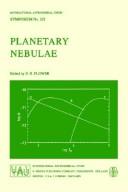
ISBN: 9027715572 9027715580 Year: 1983 Publisher: Dordrecht ; Boston, MA : D. Reidel,
Abstract | Keywords | Export | Availability | Bookmark
 Loading...
Loading...Choose an application
- Reference Manager
- EndNote
- RefWorks (Direct export to RefWorks)
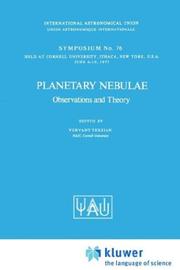
ISBN: 902770872X 9027708738 Year: 1978 Publisher: Dordrecht ; Boston, MA : D. Reidel,
Abstract | Keywords | Export | Availability | Bookmark
 Loading...
Loading...Choose an application
- Reference Manager
- EndNote
- RefWorks (Direct export to RefWorks)
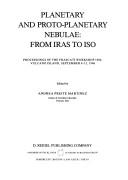
ISBN: 9027725179 9401082286 9400938918 Year: 1987 Volume: vol 135 Publisher: Dordrecht Boston Lancaster Reidel
Abstract | Keywords | Export | Availability | Bookmark
 Loading...
Loading...Choose an application
- Reference Manager
- EndNote
- RefWorks (Direct export to RefWorks)
52 --- Planetary nebulae --- Proto-planetary nebulae --- Post-AGB objects (Astrophysics) --- Post-asymptotic giant branch objects (Astrophysics) --- PPNe (Astrophysics) --- Protoplanetary nebulae --- Nebulae, Planetary --- Interstellar matter --- Stars --- Astronomie. Astrofysica. Ruimteonderzoek. Geodesie --- Congresses
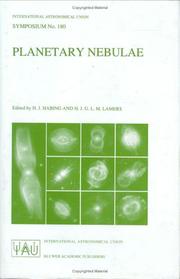
ISBN: 0792348923 0792348931 9401152446 Year: 1997 Volume: 180 Publisher: Kluwer,
Abstract | Keywords | Export | Availability | Bookmark
 Loading...
Loading...Choose an application
- Reference Manager
- EndNote
- RefWorks (Direct export to RefWorks)
Planetary nebulae present a fascinating range of shapes and morphologies. They are ideal laboratories for the study of different astrophysical processes: atomic physics, radiative transfer, stellar winds, shocks, wind-wind interaction, and the interaction between stellar winds and the interstellar medium. In addition, planetary nebulae provide information about the late stages of stellar evolution. In the last five years studies of planetary nebulae have progressed very rapidly and new phenomena and insights have been gained. This is partly due to new observations (e.g. from the Hubble Space Telescope, the ISO satellite and new infrared and millimeter spectrographs) and partly to the advancement of hydrodynamic simulations of the structures of planetary nebulae (PN). Many of these new results were reported at IAU Symposium 180 in Groningen, the Netherlands, on August 26 to 30, 1996. This symposium was dedicated to one of the pioneers of PN research: Stuart Pottasch. These proceedings contain chapters on: Introduction to PN with the basic parameters Distances of PN The central stars of PN The envelopes of PN The evolution from AGB to PN The evolution from PN to white dwarfs PN in the galactic context PN in extragalactic systems The future of PN research . The book contains 29 reviews and more than 200 shorter contributions.
52 <063> --- Astrometry --- -Planetary nebulae --- -Nebulae, Planetary --- Interstellar matter --- Stars --- Positional astronomy --- Spherical astronomy --- Astronomie. Astrofysica. Ruimteonderzoek. Geodesie--Congressen --- Congresses --- Astronomy & Astrophysics --- Physical Sciences & Mathematics --- Astronomy - General --- Planetary nebulae --- Astrophysics --- -Astronomie. Astrofysica. Ruimteonderzoek. Geodesie--Congressen --- Astronomy --- Observations, Astronomical. --- Astronomy—Observations. --- Astrophysics. --- Astronomy, Observations and Techniques. --- Astrophysics and Astroparticles. --- Astronomical physics --- Cosmic physics --- Physics --- Astronomical observations --- Observations, Astronomical
Book
ISBN: 1461417813 9786613711786 1461417821 128085393X Year: 2012 Publisher: New York, NY : Springer New York : Imprint: Springer,
Abstract | Keywords | Export | Availability | Bookmark
 Loading...
Loading...Choose an application
- Reference Manager
- EndNote
- RefWorks (Direct export to RefWorks)
Astronomers' Observing Guides provide up-to-date information for amateur astronomers who want to know all about what is it they are observing. This is the basis of the first part of the book. The second part details observing techniques for practical astronomers, working with a range of different instruments. Planetary Nebulae and How to Observe Them is intended for amateur astronomers who want to concentrate on one of the most beautiful classes of astronomical objects in the sky. This book will help the observer to see these celestial phenomena using telescopes of various apertures. As a Sun-like star reaches the end of its life, its hydrogen fuel starts to run out. It collapses until helium nuclei begin nuclear fusion, whereupon the star begins to pulsate, each pulsation throwing off a layer of the star's atmosphere. Eventually the atmosphere has all been ejected as an expanding cloud of gas, the star's core is exposed and ultraviolet photons cause the shell of gas to glow brilliantly - that's planetary nebula. Topics covered in this book include the astrophysical makeup of planetary nebulae, a history of their discovery, classification and description, telescopes, filters and observing techniques - in short everything anyone would need to observe planetary nebulae. A special feature of this book is the inclusion of over 100 nebulae in our Milky Way Galaxy personally observed by the author using telescopes of various sizes, enabling readers to make up their own observing program or to follow the authors program. The guide also includes photographs by the author of each object for ease of identification along with their celestial coordinates, magnitudes and other pertinent information. Here is a volume that should be a welcome addition to any amateur astronomer's personal library, observing course, or school. With it in hand, you can begin sampling right away some of the most captivating objects in the sky. body>.
Astronomy. --- Physics. --- Planetary nebulae -- Observers' manuals. --- Planetary nebulae --- Astronomy & Astrophysics --- Physical Sciences & Mathematics --- Astrophysics --- Astronomy - General --- Planetary nebulae. --- Nebulae, Planetary --- Observations, Astronomical. --- Astronomy --- Astronomy, Observations and Techniques. --- Popular Science in Astronomy. --- Optics, Lasers, Photonics, Optical Devices. --- Observations. --- Astronomical observations --- Observations, Astronomical --- Natural philosophy --- Philosophy, Natural --- Physical sciences --- Dynamics --- Space sciences --- Interstellar matter --- Stars --- Astronomy—Observations. --- Lasers. --- Photonics. --- New optics --- Optics --- Light amplification by stimulated emission of radiation --- Masers, Optical --- Optical masers --- Light amplifiers --- Light sources --- Optoelectronic devices --- Nonlinear optics --- Optical parametric oscillators
| Listing 1 - 8 of 8 |
Sort by
|

 Search
Search Feedback
Feedback About
About Help
Help News
News